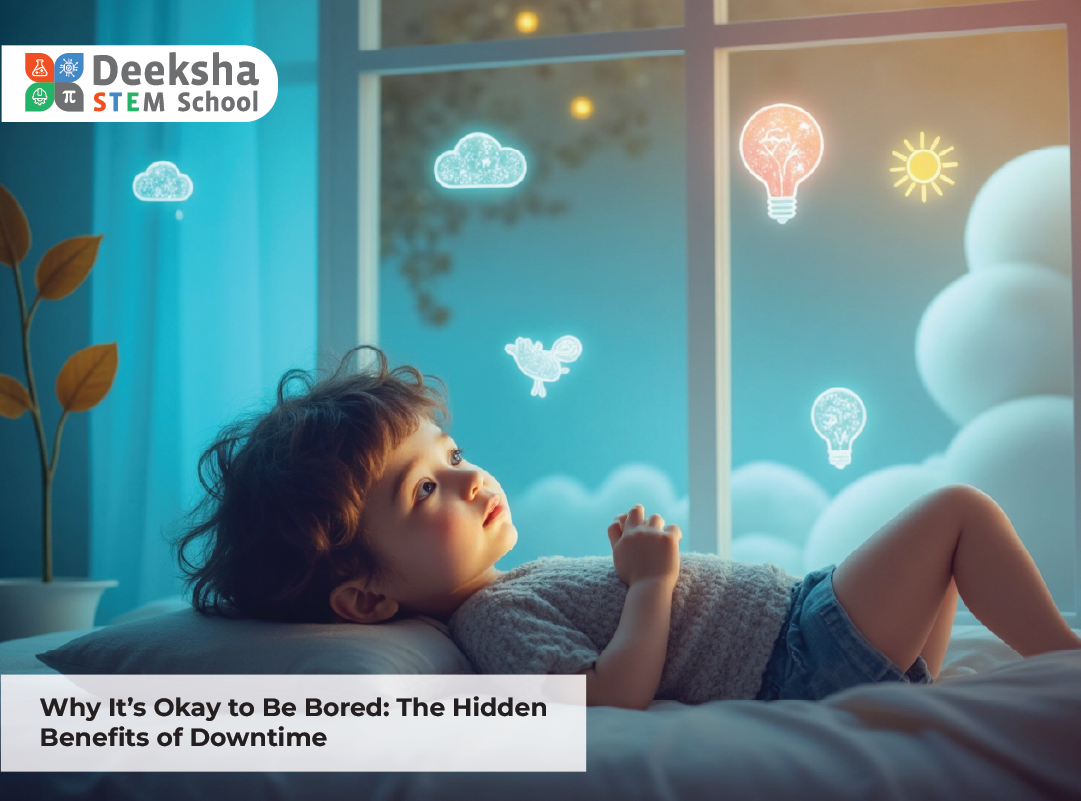Why It’s Okay to Be Bored: The Hidden Benefits of Downtime

In a world that glorifies productivity, instant gratification, and non-stop engagement, boredom has become almost taboo. Children are especially prone to expecting continuous entertainment—from screens, toys, classes, or schedules. But what happens when that stimulation pauses? Instead of viewing boredom as a problem to fix, we should recognize it as a powerful tool for development.
At Deeksha STEM Schools, we take a progressive stance on downtime. We believe that boredom isn’t wasted time—it’s fertile ground for growth. Just as the body needs rest to grow stronger, the mind needs quiet moments to develop creativity, self-awareness, and resilience. Let’s explore how boredom can benefit children in lasting and unexpected ways.
What Happens to the Brain During Boredom?
When the brain is not actively engaged in a task, it doesn’t switch off—it switches gears. This is when the brain activates the “default mode network,” a neural system linked to introspection, imagination, and memory processing. For children, these periods are crucial because they:
- Strengthen their ability to come up with unique solutions to problems
- Allow emotions to be processed in a safe, reflective way
- Help the brain consolidate what’s been learned, making it stick better
- Encourage daydreaming, storytelling, and make-believe scenarios
- Offer space for goal-setting and big-picture thinking
This seemingly idle state can unlock some of a child’s most powerful cognitive and emotional capabilities.
Why Boredom Is Beneficial for Children
| Benefit | How It Helps Your Child |
| Sparks Creativity | Bored children often invent their own games, build stories, or repurpose household items into new worlds |
| Builds Resilience | Tolerating boredom teaches patience, frustration management, and emotional control |
| Encourages Independence | Without someone telling them what to do, kids learn to think and act on their own ideas |
| Reduces Overstimulation | Breaks from screens and structured activities allow the nervous system to reset |
| Promotes Self-Discovery | Children find new interests, rediscover forgotten hobbies, and understand what excites them |
| Stimulates Critical Thinking | With nothing pre-designed to guide them, kids think through scenarios, questions, and challenges freely |
When we stop trying to fill every moment, we give our children the chance to fill it themselves—with imagination, curiosity, and problem-solving.
How Deeksha STEM Fosters Constructive Downtime
We intentionally create space for calm within our curriculum. At Deeksha STEM Schools, downtime isn’t accidental—it’s embedded into the rhythm of the day. Our programs support mental flexibility and emotional depth by incorporating:
- Quiet Thinking Periods: Designed times during class where students can journal, doodle, or reflect quietly to encourage internal processing
- Unstructured Play Time: Outdoor and indoor free play sessions allow children to invent, collaborate, and explore without rigid expectations
- Creative Corners: Open-access learning zones stocked with craft materials, building kits, puzzles, and story starters that promote spontaneous engagement
- Mindfulness Integration: Techniques such as deep breathing, guided visualization, and nature observation woven into the school routine
- Choice-Based Learning Projects: Time allotted for students to pursue a project of their choosing builds decision-making skills and intrinsic motivation
This balance between structure and freedom helps our students develop independence, creativity, and emotional regulation.
Tips for Parents: Encouraging Healthy Boredom at Home
- Schedule White Space: Leave portions of the day open without planned activities or digital stimulation
- Use Open-Ended Toys: Blocks, art supplies, costumes, and nature items inspire imagination and storytelling
- Introduce Low-Tech Challenges: Encourage activities like building a fort, creating a comic strip, or inventing a new game
- Normalize the Feeling: Let your child know it’s okay to feel bored—it’s a starting point, not a dead end
- Pause Before Offering Solutions: Instead of fixing their boredom, ask what they think they could do with their time
- Rotate Books and Toys: Changing available materials can make familiar items feel new and spark fresh interest
- Lead by Example: Spend some of your own downtime reading, writing, or relaxing without a screen—it teaches by modeling
Parents who treat boredom as an opportunity, rather than a nuisance, empower their children to become self-driven thinkers and creators.
Frequently Asked Questions
1. Isn’t boredom just a sign of laziness?
- No. Boredom signals that the brain is craving engagement—but not necessarily passive input. It’s often the trigger that leads to deep thought, innovation, or emotional insight. It can be the first step toward creativity or problem-solving.
2. Won’t too much boredom make my child unproductive?
- If boredom becomes chronic and unsupported, it can lead to disengagement. However, when paired with access to tools and encouragement, boredom nurtures initiative and curiosity. Think of it as a blank page waiting for a story.
3. How can I tell if my child is using downtime constructively?
- Children using downtime will tend to initiate their own play, ask meaningful questions, or explore interests like reading, drawing, or inventing. The key is spontaneous engagement, not just waiting passively.
4. How does Deeksha STEM ensure boredom leads to growth?
- We provide safe environments and rich stimuli while allowing flexibility. Our staff gently guides children during unstructured time, helping them reflect, make choices, and explore without interference.
5. Is structured play better than free time?
- Both have value. Structured play builds targeted skills and discipline, while free time unlocks internal motivation, creativity, and emotional insight. At Deeksha STEM, we balance both for holistic growth.
Final Thoughts
Boredom isn’t the enemy. It’s a necessary pause—a fertile ground where imagination grows, where the brain connects dots, and where creativity finds its voice. When we allow children moments of quiet, unfilled time, we hand them the gift of self-awareness, problem-solving, and emotional independence.
At Deeksha STEM Schools, we view downtime not as a break from learning, but as a different kind of learning—one that comes from within. Our classrooms are designed to provide this balance so every student can develop not just academic excellence, but the confidence to explore their own ideas.
Visit our campuses at Bannerghatta Road, Judicial Layout, Kengeri, and Vidyanagar to witness how we cultivate self-driven learners through the power of meaningful pauses and mindful education.



